Portugal
Portugal became my destination in 2005, and I went in search of Prince Henry the Navigator who is a character of Karen L. Abrahamson’s YA novel called The Cartographer’s Daughter. In one month I still couldn’t visit all the corners of Portugal, but what I saw made me want to return.

The Minho – air like wine
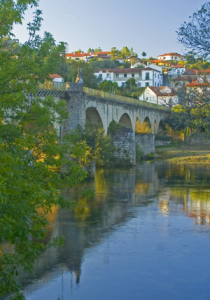
Pont de Barques sits in the northern part of Portugal known as the Minho. It slumbers along its river, but in September, when the grapes hang lush and ripe from the vine, the one bridge in town becomes clogged with farmers bringing the ripe fruit into the town co-op. Picture tractors driven by lovely old farmers drawing oaken casks heaped with white or red grapes. Picture me trying – unsuccessfully – to get a picture of the grapes being brought in.
Early in the morning from the sleepy town we followed the river up into mountains – yes, true mountains that set the border with France, to a sleepy town called Parada to go hiking. The road quickly rose to the tree line where numerous villages dotted the steep mountain sides. After false starts because the road had been changed and thus the markers for the trails had been lost or changed, we found ourselves walking a back street of Parada. Think cobbles and dirt and old granite buildings and grape arbors that filled the air with a scent so rich and sweet it was like breathing in wine as we walked vine-shadowed lanes. The scent of cattle bier, and grain from the communal espigueiros (grain biers that looked suspiciously like coffins with the crosses on their tops), and the hot sunshine all conspired to make this hot work. The comfy cats snoozing in bits on sunlight on stairs and stone walls had the right idea.
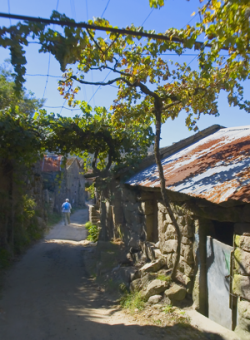
I said good day to a local woman and she asked me what language I spoke. When I told her, she broke into clear English. I said it was a lovely village and she agreed, but said it was very old and she had fixed up one of the houses, but one of her sons had not. She said she keeps telling him to put in a proper sewer etc., but he hasn’t and her disgust was clear. I told her sons were like that – not wanting to do things their mother’s way and we laughed and she sent me on my way.
Getting drunk on the air, we followed stone fences upwards through oak and chestnut and arbutus and alder past vivid green fields that must be watered using the ancient Rabiera method that floods fields using channels from local streams. The trail turned muddy and we leapt from stone to stone finally coming out into an area of no trees and sun-warmed, granite stone the glaciers had smoothed long ago.
The soil grew golden broom, purple heather and colchique flowers, and blackberry brambles and ferns so thick and lush they grew chest high. The trail wasn’t well marked and we got lost again in a forest of ferns, but eventually came out where a small group of barosã cattle lounged. With their huge, lyre-shaped horns and golden coats, they were like legendary beasts you weren’t too sure about approaching. Bird song filled the air.
From there it was downhill – literally – following old stone roads worn to ruts by wagon passage and then into desolation. The trail markers said we couldn’t enter the grape arbors again, even though we could smell the sweet scent and hear the cock crows and the gentle ring of cow bells. Instead the trail markers sent us up a road newly cut into the mountain and eventually back to our car. We got our reward for our sweaty work however: we found an old stone mill and pool of cold, cold water. So I sat on the rough granite and soaked my legs until it was time to head back to Pont de Barques.
Back in town I sat drinking Dominus beer by the bridge, still trying to get a photograph of the men bringing the grape harvest to town in their huge oaken casks, but it seemed like traffic and circumstance conspired against me. I waited. And waited. And finally a handsome farmer took pity on me. Success!
I learned things don’t come easy in the Minho, but with persistence like the old woman with her son, they come to those who patiently wait.
September 2005
Sagre – In Search of Prince Henry
Everywhere you go in Portugal you find reminders of Prince Henrique the Navigator. Born in Porto, with lands in the north and a place at the palaces of Evora, but it was here, at Sagre (prouncounced Sagresh) that Prince Henry the Navigator captured the world’s imagination. And yet few know who he was.
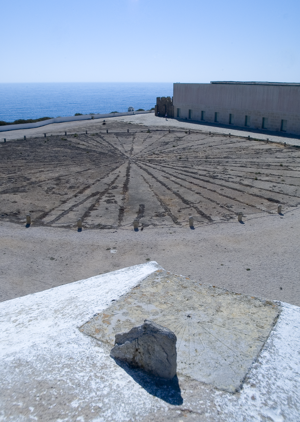
Sagre sits where a finger of land pokes into the Atlantic, only a few miles from Cabo Sao Vincente, the westernmost point of Europe. The landscape is desolate here. Flat, rocky and inhabited mainly by a few intrepid shepherds and their flocks. Yes, there are a few eucalyptus and pine battered by the constant Atlantic winds, but the main, red-brown landscape is scared rock and brush and stunted grasses. Here and there a low stone house huddles as if barely hanging on against the sun and wind. Hard stone and red dust and low, dark foliage as if plants lower their heads under the onslaught from beyond the ends of the earth.
The town of Sagre is, well, a bump in the road. A small line of houses and restaurants lining the road down to the harbor and establishments catering to the surfers and budget travelers who come here. This isn’t a big tourist town.
Most of Sagre is cliffs of red stone and startlingly turquoise water and curves of cream sand crescent beaches. The town is a few low buildings of blue and white with homeowners who will take you in for 20 Euros a night. But far out on the water as the sun sets you get a sense of Prince Henry’s time in the silent image of a sailing ship ghosting across the horizon as the mists rise out of the ocean and begin to eat at the lands.
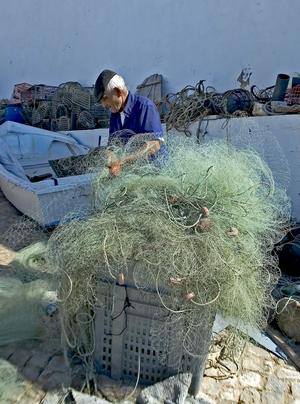
The finger of land that holds the remains of Prince Henry’s fortress opens at 9:30 each morning. Thick walls cut off the finger of land from any land-based attack and the treacherous cliffs would stop any attack by sea. Beyond the thick walls await a lone white church, the remains of the other buildings that once stood there and – wonder of wonders – a huge compass rose laid into the broken main courtyard that perhaps gave rise to the legend that Prince Henry had built a cartographer’s school at Sagre.
Not so, say the historians, but seeing those immense lines radiating out to all the points of the compass brings home the point that Prince Henry the Navigator must be given credit as one of those who started the great age of discovery. It was his patronage that led to the mapping voyages down the west coast of Africa that eventually led to the Vasco de Gama’s discovery of a water route to India and the Far East.
At Sagre you can look out at Cabo Sao Vincent, listen to the pounding surf and watch the faces of the men who fish down the Sagre cliffs and understand why a religious man like Prince Henry would come here and build a dream of exploring beyond these rugged precipices. Something – a dream, perhaps – exists out beyond the place where sea and sky collide and become – something else.
September 2005
The Romani – The gypsies of Portugal
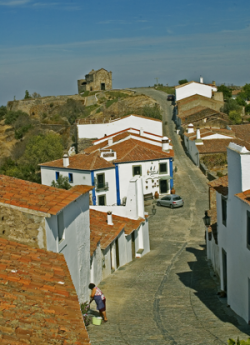
Sipping coffee in Albufeira of the Algarve Coast while waiting for the bus north to the Alentejo area of Portugal I noticed the camp out beyond the bus station. Romani. Actually it wasn’t the first time I’d run into the Romani people in Portugal. In the Minho the festival at Pont de Lima had brought in a huge encampment who ran the festival rides and many of the market kiosks. At another of the massive markets in the north, again most of the sellers had been Romani. Driving down the road we came across wagons being driven by Romani families. They shook their fists when I took their picture.
But this was different – not a matter of worrying about light-fingered children or shoddy merchandise sold for too high a price or a beating – no, this was where they lived. Another world, really, across the fence from the diesel-scented bus depot.
A thin man sorted something from tattered canvas bags. A curly-headed child – oddly almost blonde – perhaps a foundling, and a sloe-eyed, slattern-hipped woman with her hair in a thick braid down her back, wearing a long black skirt that fit over her wide hips and love-goddess, fecund belly. They moved in slow motion amid a litter of red and bright yellow carts and harness and horse collars. A donkey cart with huge wooden wheels came up, loaded with people, the donkey’s harness bright with red and white embroidery. An older man and woman hauled a bucket of water from somewhere else.
Their lives seemed a place between. There were brilliant white townhouses built in the valley and up the Algarve side hill beyond, many of them British-owned winter homes. There at the bus terminal, the earth was paved and there were modern buses, but where these people lived, where they gathered around a fallen tree, there existed only an abandoned house, cardboard and tin slapped together as roofing. Garbage – a garden of plastic bags and coke tins and plastic cups and crumpled paper and cigarette butts spread out from the house like thistle seed pods.
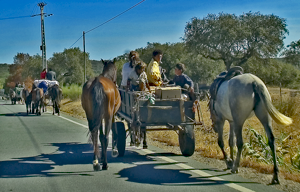
They were separate. They were apart and seemed to prefer to remain that way. And the fecund woman led the small, blonde child away down a dusty road and it seems there was no way to get him back. Who was he? A lost king? A lost chance? A lost hope? All this caught in a child led away towards the world of the white town houses.
I wondered who she would give him to, or what she might get in return.
October 2005









